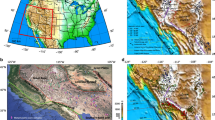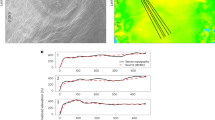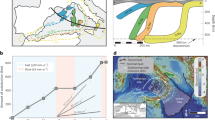Abstract
Field-based geological studies show that continental deformation preferentially occurs in young tectonic provinces rather than in old cratons1. This partitioning of deformation suggests that the cratons are stronger than surrounding younger Phanerozoic provinces. However, although Archaean and Phanerozoic lithosphere differ in their thickness2,3,4 and composition4,5, their relative strength is a matter of much debate. One proxy of strength is the effective elastic thickness of the lithosphere, Te. Unfortunately, spatial variations in Te are not well understood, as different methods yield different results. The differences are most apparent in cratons, where the ‘Bouguer coherence’ method yields large Te values (> 60 km)6,7,8,9 whereas the ‘free-air admittance’ method yields low values (< 25 km)10. Here we present estimates of the variability of Te in Europe using both methods. We show that when they are consistently formulated11, both methods yield comparable Te values that correlate with geology, and that the strength of old lithosphere (≥ 1.5 Gyr old) is much larger (mean Te > 60 km) than that of younger lithosphere (mean Te < 30 km). We propose that this strength difference reflects changes in lithospheric plate structure (thickness, geothermal gradient and composition) that result from mantle temperature and volatile content decrease through Earth's history.
This is a preview of subscription content, access via your institution
Access options
Subscribe to this journal
Receive 51 print issues and online access
$199.00 per year
only $3.90 per issue
Buy this article
- Purchase on Springer Link
- Instant access to full article PDF
Prices may be subject to local taxes which are calculated during checkout


Similar content being viewed by others
References
McConnell, R. B. Geological development of the rift system of Eastern Africa. Geol. Soc. Am. Bull. 83, 2549–2572 (1972)
Polet, J. & Anderson, D. L. Depth extent of cratons as inferred from tomographic studies. Geology 23, 205–208 (1995)
Artemeieva, I. M. & Mooney, W. D. Thermal evolution of Precambrian lithosphere: A global study. J. Geophys. Res. 106, 16387–16414 (2001)
Jordan, T. H. Composition and development of the continental lithosphere. Nature 274, 544–548 (1978)
O'Reilly, S. Y., Griffin, W. L., Poudjom Djomani, Y. H. & Morgan, P. Are lithospheres forever? Tracking changes in subcontinental mantle through time. GSA Today 11(4–10) (2001)
Bechtel, T. D., Forsyth, D. W., Sharpton, V. L. & Grieve, R. A. F. Variations in the effective elastic thickness of the North American lithosphere. Nature 343, 636–638 (1989)
Forsyth, D. Subsurface loading and estimates of the flexural rigidity of continental lithosphere. J. Geophys. Res. 90, 12623–12632 (1985)
Audet, P. & Mareschal, J.-C. Variations in elastic thickness in the Canadian Shield. Earth Planet. Sci. Lett. 226, 17–31 (2004)
Swain, C. J. & Kirby, J. F. The effect of ‘noise’ on estimates of the elastic thickness of the continental lithosphere by the coherence method. Geophys. Res. Lett. 30, 1574–1578, doi: 10.1029/2003GL017070 (2003)
McKenzie, D. Estimating Te in the presence of internal loads. J. Geophys. Res. 108, doi:10.1029/2002JB001766 (2003)
Pérez-Gussinyé, M., Lowry, A., Watts, A. B. & Velicogna, I. On the recovery of the effective elastic thickness using spectral methods: examples from synthetic data and the Fennoscandian shield. J. Geophys. Res. 109, doi: 10.1029/2003JB002788 (2004)
Grotzinger, J. & Royden, L. Elastic strength of the Slave craton at 1.9 Gyr and implications for the thermal evolution of the continents. Nature 347, 64–66 (1990)
Windley, B. in A Continent Revealed. The European Geotraverse (eds Blundell, D., Freeman, R. & Mueller, S.) 139–214 (Cambridge Univ. Press, Cambridge, UK, 1992)
Kogan, M. G., Fairhead, J. D., Balmino, G. & Makedonskii, E. L. Tectonic fabric and lithospheric strength of northern Eurasia based on gravity data. Geophys. Res. Lett. 21, 2653–2656 (1994)
Poudjom Djomani, Y. H., Fairhead, J. D. & Griffin, W. L. The flexural rigidity of Fennoscandia: reflection of the tectonothermal age of the lithospheric mantle. Earth Planet. Sci. Lett. 174, 139–154 (1999)
Cloetingh, S. et al. Lithospheric memory, state of stress and rheology: neotectonic controls on Europe's intraplate continental topography. Quat. Sci. Rev. 24, 241–305 (2005)
Stewart, J. & Watts, A. B. Gravity anomalies and spatial variations of flexural rigidity at mountain ranges. J. Geophys. Res. 102, 5327–5352 (1997)
McBride, J. H., Snyder, D. B., England, R. W. & Hobbs, R. W. Dipping reflectors beneath old orogens: A perspective from the British Caledonides. GSA Today 6, 1–6 (1996)
Mona Lisa Working Group, Closure of the Tornquist Sea: constraints from MONA LISA deep reflection seismic data. Geology 22, 617–620 (1997)
Boschi, L., Ekstroem, G. & Kutowski, B. Multiple resolution surface wave tomography, the Mediterranean basin. Geophys. J. Int. 157, 293–304 (2004)
Watts, A. B. & Burov, E. Lithospheric strength and its relationship to the elastic and seismogenic layer thickness. Earth Planet. Sci. Lett. 213, 113–131 (2003)
Pollack, H. Cratonization and thermal evolution of the mantle. Earth Planet. Sci. Lett. 80, 175–182 (1986)
Ussami, N., Cogo de Sa, N. & Molina, E. C. Gravity map of Brazil. 2. Regional and residual anomalies and their correlation with major tectonic provinces. J. Geophys. Res. 98, 2199–2208 (1993)
Hartley, R., Watts, A. B. & Fairhead, J. D. Isostasy of Africa. Earth Planet. Sci. Lett. 137, 1–18 (1996)
Pearson, D. G. et al. Archaean Re-Os age for Siberian eclogites and constraints on Archaean tectonics. Nature 374, 711–713 (1995)
Dixon, J. E., Dixon, T. H., Bell, D. R. & Malservisi, R. Lateral variation in upper mantle viscosity: role of water. Earth Planet. Sci. Lett. 222, 451–467 (2004)
Christensen, N. I. & Mooney, W. D. Seismic velocity, structure and composition of the continental crust—global view. J. Geophys. Res. 100, 9761–9788 (1995)
Doin, M. P., Felitout, L. & Christensen, U. Mantle convection and the stability of depleted and undepleted continental lithosphere. J. Geophys. Res. 102, 2771–2787 (1997)
Lenardic, A., Moresi, L. N. & Mulhaus, L. N. Longevity and stability of cratonic lithosphere: Insight from numerical simulations of coupled mantle convection and continental tectonics. J. Geophys. Res. 108, doi: 10.1029/2002JB001859 (2003)
Laske, G., Masters, G. & Reif, C. The Reference Earth Model Website. http://mahi.ucsd.edu/Gabi/rem.html (2000).
Goodwin, A. M. Principles of Precambrian Geology (Academic, San Diego, California, 1996)
Brendan Murphy, J. & Nance, D. Sm-Nd isotopic systematics as tectonic tracers: an example from West Avalonia in the Canadian Appalachians. Earth Sci. Rev. 59, 77–100 (2002)
Wessel, P. & Smith, W. H. F. Free software helps map and display data. Eos 72, 441–446 (1991)
Acknowledgements
We thank D. Fairhead (GETECH, UK) for the provision of the gravity anomaly and topography data used in this Letter, J.-C. Mareschal and T. Lowry for constructive comments, and B. Holtzman, C. Mac Niocaill, S. Lamb, C. R. Ranero, J. Phipps Morgan, T. Jordan, T. Cunha, J. Hillier and G. Kozyreff for comments and discussions about the Letter. This work was supported by NERC. The figures presented here were constructed using GMT33.
Author information
Authors and Affiliations
Corresponding author
Ethics declarations
Competing interests
Reprints and permissions information is available at npg.nature.com/reprintsandpermissions. The authors declare no competing financial interests.
Supplementary information
Supplementary Figure S3
Dependence of Te on window size (PDF 91 kb)
Supplementary Figure Legend
Caption to accompany the above Supplementary Figure. (DOC 19 kb)
Rights and permissions
About this article
Cite this article
Pérez-Gussinyé, M., Watts, A. The long-term strength of Europe and its implications for plate-forming processes. Nature 436, 381–384 (2005). https://doi.org/10.1038/nature03854
Received:
Accepted:
Issue Date:
DOI: https://doi.org/10.1038/nature03854
This article is cited by
-
Tectonic control on effective elastic thickness over the Northeast Indian Seamount Province and surrounding regions
Marine Geophysical Research (2021)
-
Elastic Thickness Determination from on-orbit GOCE Data and CRUST1.0
Pure and Applied Geophysics (2019)
-
A note on estimating \(T_{e}\) T e from Bouguer coherence
GEM - International Journal on Geomathematics (2016)
-
Geophysical Investigation of Lithosphere Structure Beneath Sri Lanka Using Surface and Internal Load Variations
Pure and Applied Geophysics (2014)
-
Structure of orogenic belts controlled by lithosphere age
Nature Geoscience (2013)
Comments
By submitting a comment you agree to abide by our Terms and Community Guidelines. If you find something abusive or that does not comply with our terms or guidelines please flag it as inappropriate.



